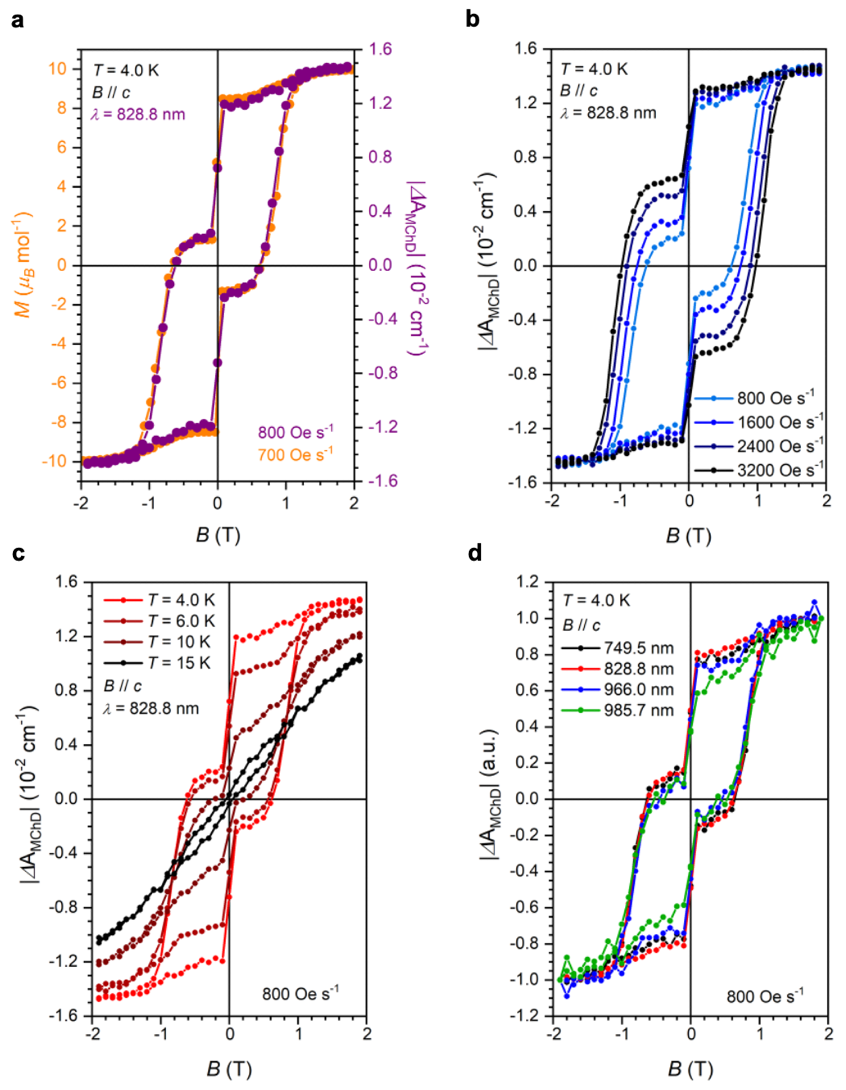Cyrille Train and Matteo Atzori, LNCMI-Grenoble.
Magnetic materials are widely used for many technologies in areas such as energy, health, transportation, computation, and data storage. For the latter, the readout of the magnetic state of a medium is crucial. Optical readout based on the magneto-optical Faraday effect was commercialized, but soon abandoned because of the need for a complex circular polarization-sensitive readout. In this work, we demonstrate that this obstacle can be removed combining chirality with magnetism as chiral magnetic materials exhibit magneto-chiral dichroism (MChD), a differential absorption of unpolarized light dependent on their magnetic state. By using molecular-chemistry principles, we have rationally implemented chirality into single-molecule magnets (SMMs), ultimate nanoobjects capable of retaining magnetization. Then, we have characterized the magnetic properties of this system through temperature- and magnetic-field-dependent magnetic measurements on single crystals, revealing an opening of the hysteresis cycle at low temperature (4.0 K) as a consequence of a strong axial magnetic anisotropy of the used Dy ion. Magneto-chiral-dichroism studies as a function of temperature- and applied magnetic field, whose polarity is changed at frequencies varying between 0.01 and 0.1 Hz (with sweep rates of 800 – 8000 Oe s-1), revealed sharp and strong MChD signals associated with the f-f electronic transitions of the Dy ion.
To allow a direct comparison between MChD and magnetization curves and to probe the retention of the magnetization of the system with unpolarized light through MChD, we have adapted the measurement protocol for the investigation of MChD in dynamic conditions. It consists of sweeping the magnetic field with a triangular profile up and down between opposite polarities (±2 T in the present case, but extendable to ±7 T using the LNCMI resistive magnets) and measuring continuously light-absorption spectra, similarly to what is done in magnetic-hysteresis measurements performed with a magnetometer. This protocol provides high-resolution/high-sensitivity MChD spectra that allow accurate probing of the optical response of the system during the magnetic-field sweep. The magneto-chiral optical data accurately reproduce the hysteresis cycle (figure 1a) and the fine features associated with the quantum tunneling of the magnetization at zero field (figure 1b). The temperature dependence of the hysteresis opening follows the magnetometry findings (figure 1c) and the same behavior can be probed at different wavelengths (figure 1d). This clearly demonstrates that upon implementation of chirality in SMM, unpolarized light is able to probe the magnetic information stored in SMMs through MChD, even at zero field. This study, thus, represents a paradigm shift in the field of optical-data readout. It can indeed be considered as a proof of concept for the readout of the information stored in ultimate small dimensions of magnetic molecular memories and paves the way for the development of novel polarization-free optical-data readout technologies.

Figure: (a) Comparison between the magneto-chiral optical data extracted by MChD measurements (purple dots) and magnetization measurements (orange dots) as a function of B. (b) Variation of the opening of the hysteresis loop detected by unpolarizedlight irradiation under magnetic field for various magnetic-field sweep rates at T = 4.0 K and (c) for different temperatures. (d) Magneto-chiral optical response for different wavelengths at the same temperature and sweep rate.
Optical Readout of Single-Molecule Magnets Magnetic Memories with Unpolarized Light, M. S. Raju, K. Paillot. I. Breslavetz, G. Novitchi, G. L. J. A. Rikken, C. Train, and M. Atzori, J. Am. Chem. Soc. 146, 23616 (2024).
https://pubs.acs.org/doi/10.1021/jacs.4c08684
Contact: cyrille.train@lncmi.cnrs.fr, matteo.atzori@lncmi.cnrs.fr






